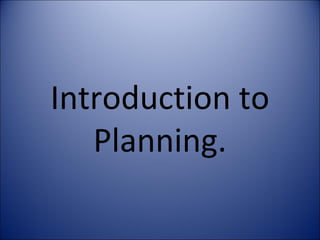
Introduction to planning
- 2. What is planning and why you need to plan? • Planning is one of the most important project management and time management techniques. Planning is preparing a sequence of action steps to achieve some specific goal. If you do it effectively, you can reduce much the necessary time and effort of achieving the goal. • A plan is like a map. When following a plan, you can always see how much you have progressed towards your project goal and how far you are from your destination. Knowing where you are is essential for making good decisions on where to go or what to do next.
- 3. • One more reason why you need planning is gain the 80/20 rule. It is well established that for unstructured activities 80 per cent of the effort gives less than 20 percent of the valuable outcome. You either spend much time on deciding what to do next, or you are taking many unnecessary, unfocussed, and inefficient steps towards your goal. • Planning is also crucial for meeting your needs during each with your time, money, or other resources. With careful planning you often can see if at some point you are likely to face a problem. It is much easier to adjust your plsn to avoid or smoother a coming crisis, rather than to deal with the crisis when it comes unexpected.
- 4. How to write an action plan? • When writing an action plan to achieve a particular goal or outcome, you can get much help from the following steps. • Clarify your goal. Can you get a visual picture of the expected outcome? How can you see if you have reached your destination? What does make your goal measurable? What constraints do you have, like the limits on time, money, or other resources.
- 5. • Write a list of actions. Write down all actions you may need to take to achieve your goal. At this step focus on generating and writing as many different options and ideas as possible. Take a sheet of paper and write more and more ideas, just as they come to your mind. While you are doing this, try not to judge or analyze. • Analyze, prioritize, and prune. Look at your list of actions. What are the absolutely necessary and effective steps to achieve your goal? Mark them somehow. After that, what action items can be dropped from in the plan without significant consequences for the outcome. Cross them out.
- 6. • Organize your list into a plan. Decide on the order of your action steps. Start from looking at your marked key actions. For each action, what other steps should be completed before that action? Rearrange your actions and ideas into a sequence of ordered action steps. Finally, look at your plan once again. Are there any ways to simplify it even more? • Monitor the execution of your plan and review the plan regularly. How much have you progressed towards your goal by now? What new information you have got? Use this information to further adjust and optimize your plan.
- 7. Using a goal setting form or worksheet • A goal setting form or worksheet has certain advantages. They may be a convenient learning tool when making first goal setting steps, like in high school lessons. Goal setting forms or worksheets can also be helpful if you feel they stimulate you to actually sit and write your goals. They are also easy if you use them for a one time goal setting exercise, just to fill them out and forget.
- 8. • After you learn basic goal setting principles and acquire some goal writing skills, you can do even better with just a plain sheet of paper. At least if you don't have many goals to manage. • As soon as you grow more serious about your goals and objectives, and it is not just a one time exercise, a simple paper system or just a goal setting form will slow you down. • In particular, while it is important to stick to your goals, you need significant flexibility in your objectives and activities. Your objectives are important part of goal planning process, as they serve your goals and connect them to changing circumstances. Even if the direction of your goals does not change, time after time you feel the need to clarify their formulation.
- 9. • With a paper system it is easy to become reluctant to sharpen your goals or readjust your objectives to new facts and experiences. It is just too much rewriting work. Of course, doing that rewriting work may help to keep your goal setting system alive, but will be taking more of your time. It is also quite difficult to have a visible hierarchy of your goals, objectives, and activities. In any case, with a goal setting form or worksheet, or just plain paper, you serve your goal writing system rather than the system serves you.
- 10. • With a paper system it is easy to become reluctant to sharpen your goals or readjust your objectives to new facts and experiences. It is just too much rewriting work. Of course, doing that rewriting work may help to keep your goal setting system alive, but will be taking more of your time. It is also quite difficult to have a visible hierarchy of your goals, objectives, and activities. In any case, with a goal setting form or worksheet, or just plain paper, you serve your goal writing system rather than the system serves you.